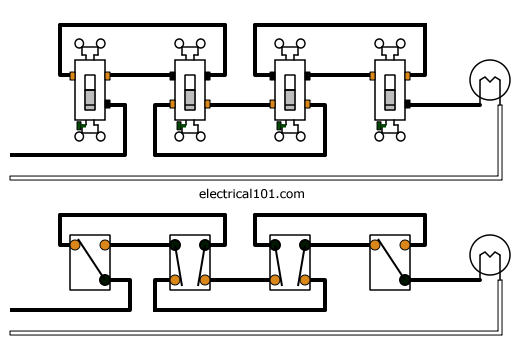This may be overly lazy but I an wondering if it is possible to have both side porch lights be controlled from either side of the cabin. Two switches controlling a single 12volt LED. I am not really seeing anything that specifically says it is doable during my internet searches. The closest I have come is a DPDT Toggle Switch but I think that is two lights one switch. I am looking for 1 light two switches like in a 3way switch in the 120v AC world.
The reasoning is if the teardrop buddy wants to go for a roam in the middle of the night and would like the porch light on. Be nice to not have to reach across. And in the much more likely event, I am solo, I wouldn't have to reach ALLLLLL the way over to the other side of the cabin to work that sides porch light.
Three way 12v switches
16 posts
• Page 1 of 2 • 1, 2
Three way 12v switches
Don Miller
Seattle
Trippinwithdon.com
Seattle
Trippinwithdon.com
- Diemjoe
- Teardrop Master
- Posts: 191
- Images: 2
- Joined: Tue Jun 10, 2014 3:42 pm
- Location: Seattle
Re: Three way 12v switches
Diemjoe wrote:This may be overly lazy but I an wondering if it is possible to have both side porch lights be controlled from either side of the cabin. Two switches controlling a single 12volt LED. I am not really seeing anything that specifically says it is doable during my internet searches. The closest I have come is a DPDT Toggle Switch but I think that is two lights one switch. I am looking for 1 light two switches like in a 3way switch in the 120v AC world.
The reasoning is if the teardrop buddy wants to go for a roam in the middle of the night and would like the porch light on. Be nice to not have to reach across. And in the much more likely event, I am solo, I wouldn't have to reach ALLLLLL the way over to the other side of the cabin to work that sides porch light.
Why not wire a momentary push button as a switch using a JK filp-flop IC then you can just wire a second button to the same inputs
-

Da'engineer - Teardrop Advisor
- Posts: 74
- Images: 2
- Joined: Wed Feb 18, 2015 4:50 pm







 . Rated 20A @120VAC means just that...
. Rated 20A @120VAC means just that...

